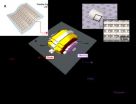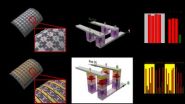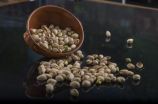(Press-News.org) With the introduction of curved smartphones, flexible electronic goods are gradually moving to the center stages of various markets. Flexible display technology is the culmination of the latest, cutting-edge electric cell device technology. Developing such products, however, requires not only a curved display, but also operational precision of other parts, including the memory, in a flexible state.
Dr. Tae-Wook Kim at KIST announced their successful development of a 64-bit memory array using flexible and twistable carbon nano material and organo-polymer compound, which can accurately store and delete data.
The most common memory cell today uses a silicone (Si)-based hard, inorganic matter, however, in order to be flexible, the materials were fabricated with a carbon-based organic compound. The recently developed memory cell uses a technology, which arranges such organic material in a single configuration at room temperature and places the material on a desired spot on the substrate. This is the core technology in enlarging the storage capacity of memory, an unprecedented discovery until now. In particular, demonstrating this on a bendable substrate required highly sophisticated technology, which signified difficulties in fabrication. The research team developed a technology with the above characteristics to make the electric current flow in one direction so that the data could be rewritable even in a curved state.
In the past, each memory device was configurated with a grating structure, but there were complications in commercializing such device due to inaccuracy in storage and deleting data caused by a cross-talk between cells in the process of expanding its capacity. Therefore, research had continuously been conducted not only on bending the memory, but on resolving such intervention issues and enhancing accuracy.
In this research, organic memory cells (resistors) based on carbon nano compounds and organic diodes to control the direction of electric currents were stacked upon each other. Once the direction of the electric current is controlled and can be made to flow in one direction, data can be made rewritable, thereby limiting any interference from nearby cells. These cells are constructed in the form of 1D-1R (1 Diode + 1 Resistor)*, which gives them flexibility with accuracy in data processing.
* 1D-1R (1 Diode + 1 Resistor) array: An architecture where a resistor, which is a memory cell, is piled upon a diode, and controls the direction of electric currents.
Previous organic memory cells were fabricated with the spin-coating method, a major solution process. However, in a continuous process such as above, the organic diode layer (1D) and the organic memory layer (1R) were damaged. Dr. Kim utilized the crosslinker* method, which can create patterns in a low temperature process, to resolve this problem. The crosslinker method enables the organic memory layer and organic diode layer to avoid damaging each other in the process of creating continuous layers. By using this method, his team managed to develop a non-volatile (where the storage capacity remains undisturbed even with the suspension of power) memory cell with an organic architecture, which was applicable on a twistable plastic substrate and with a 64-bit storage capacity.
* Crosslinker Method: A method of subjecting organic matter to ultraviolet rays to solidify the desired part with light. It can be demonstrated in a low temperature process, but it is also a way to chemically stabilize the organic matter while enabling it to maintain its original characteristics after fabrication.
In order to confirm whether the problem of cross-talk between cells was resolved, the research team succeeded in storing the letters 'KIST' while the device was bended. Such results prove that organic memory cells can also be utilized in parts of other flexible electronic goods, in addition to previous electronic cells.
According to Dr. Kim, "This research unveils the direction for research to resolve the greatest obstacle in organic memory cell research with past structures, and is expected to contribute broadly to future research on flexible electric cells and parts."
INFORMATION:
This research conducted a team led by Dr. Tae-Wook Kim at KIST Jeonbuk Institute of Advanced Composite Materials, Soft innovative materials research center, and Yongsung Ji(Academic advisor Prof. Heung Cho Ko), a doctoral program candidate at the Gwangju Institute of Science and Technology. It was published as a thesis on the world-renowned science journal Nature Communications under the title "Flexible and Twistable Non-volatile Memory Cell Array with All-organic One Diode-one Resistor Architecture," Digital Object Identifier (DOI) 10.1038/ncomms3707 on November 1, 2013. This research was sponsored as the inherent research projects of KIST and research funds from Jeonllabuk Province.
* Non-volatile Organic Memory Cell
A memory cell made from organic matter. Its fabrication technology is simple, cost-effective and can be demonstrated through a low temperature process. It can be applied to flexible plastic products and enables printing process. Currently, there are many research being conducted in this field. Between the upper electrode and lower electrode, the organic matter used as the memory material possesses two contrasting resistance states, high and low resistance states, according to the voltage received. Such state of resistance is maintained even when the external power is suspended, which is why it is highlighted as the next generation non-volatile memory cell.
* 1D-1R (1 Diode + 1 Resistor)
1D-1R is an architecture where an organic diode is stacked upon an organic resistive flexible memory cell. In order to resolve the cross-talk between cells in organic resistive flexible memory cells in the previous array, the diode was used for its rectifying action
Breakthrough development of flexible 1D-1R memory cell array
Acceleration in development of wearable computers
2014-02-18
ELSE PRESS RELEASES FROM THIS DATE:
Medicare beneficiaries return to emergency rooms after nursing home discharge
2014-02-18
Nursing homes are widely used by Medicare beneficiaries who require rehabilitation after hospital stays. But according to a recent study led by a researcher at the University of North Carolina at Chapel Hill School of Nursing, a high percentage of Medicare patients who are discharged from nursing homes will return to the hospital or the emergency room within 30 days.
"Nearly two million older adults use this benefit every year," said assistant professor Mark Toles, the first author of the study. "Before this study, we didn't recognize the large number of older adults ...
Healthy Lunchbox Challenge helps influence healthy eating habits in children
2014-02-18
AUDIO:
Falon Tilley and Michael W. Beets discuss the successful implementation of the Healthy Lunchbox Challenge, an innovative theory and incentive-based program, at four large-scale, community-based summer day camps. They observed...
Click here for more information.
PHILADELPHIA, PA, February 18, 2014 – During the school year, 21 million children receive free or reduced-price lunches, yet less than 10% of those children participate in the Department of Agriculture's Summer ...
Metal in the heart is non-hazardous to health
2014-02-18
Jena (Germany) A trousers button, a coin or a watch can be dangerous for people with a nickel allergy. Approximately 1 in 10 Germans is allergic to the metal. "This raises the question of the safety of medical implants containing nickel," explains Professor Dr. Markus Rettenmayr of the Friedrich Schiller University Jena (Germany). Nickel-titanium alloys are increasingly used as material for cardiovascular implants in minimal invasive surgery. Once implanted, nickel-titanium alloys can release small amounts of nickel due to corrosion phenomena, the holder of the Chair of ...
Investment bankers lead businesses to better mergers, acquisitions
2014-02-18
BUFFALO, N.Y. – Corporations with board directors who have investment banking experience are more likely to acquire other businesses – and make better acquisitions when they do – according to a new study from the University at Buffalo School of Management.
Forthcoming in the Journal of Financial Economics, the study found that directors with investment banking experience help their firms to select better businesses to acquire, more accurately determine the value of the target business and either reduce reliance on mergers and acquisition consultants or negotiate lower ...
Molecular biology mystery unravelled
2014-02-18
The nature of the machinery responsible for the entry of proteins into cell membranes has been unravelled by scientists, who hope the breakthrough could ultimately be exploited for the design of new anti-bacterial drugs.
Groups of researchers from the University of Bristol and the European Molecular Biology Laboratory (EMBL) used new genetic engineering technologies to reconstruct and isolate the cell's protein trafficking machinery.
Its analysis has shed new light on a process which had previously been a mystery for molecular biologists.
The findings, published today ...
Personality and spaces, remaking love, meaning in life, and commonsense morality
2014-02-18
People and spaces, the tragedy of commonsense morality, myths about meaning of life, and remaking love were four themes at the Society for Personality and Social Psychology (SPSP) conference in Austin. Researchers presented new work, showing how psychology reaches into our everyday lives. Video from four of these talks is now available online.
Highlights include:
Sam Gosling of the University of Texas-Austin described how the link between our emotions and spaces is is inseparable. As such, our spaces say a lot about us. In new work, Gosling and colleagues identified ...
One-quarter of high risk patients denied anticoagulation after AF ablation
2014-02-18
Sophia Antipolis, 18 February 2014: One-quarter of high risk patients do not receive anticoagulants after ablation of atrial fibrillation (AF), according to the latest survey of European practice.
The EORP Atrial Fibrillation Ablation Pilot Study, conducted by the European Heart Rhythm Association (EHRA) of the European Society of Cardiology (ESC), reveals that 65% of patients were taking anticoagulants one year after ablation of AF.1 But up to 25% of patients at high risk of stroke (defined as a CHA2DS2-VASc score >1) were not taking any anticoagulant drug. And around ...
A new system accelerates verification of printed electronic documents
2014-02-18
This news release is available in Spanish. Researchers at the Universidad Carlos III in Madrid have designed a system that speeds up online administrative procedures by automatically verifying and validating printed electronic documents, a process that had been done manually up until now.
With the law known as Ley 11/2007, regarding citizens' electronic access to public services, going into effect, electronic documents have gained full legal validity. When a document of this type is printed out, it must be accompanied by its Código Seguro de Verificación (CSV- Secure ...
Parents are not more likely to split up if mothers earn more than fathers
2014-02-18
Couples with young children are as likely to stay together if the mother is the main breadwinner rather than the father, new research shows.
A paper published in the journal Sociology today [Tuesday 18 February 2014] says the relationships of parents are in some cases more stable if the mother earns more than the father.
Dr Shireen Kanji, of the University of Leicester School of Management, and Dr Pia Schober, of the German Institute for Economic Research, Berlin, examined survey data on 3,944 British couples as their first child aged from eight months to seven years. ...
Food & moods
2014-02-18
Emotional eating is something we're all familiar with. Maybe you had had a rough week at work and all you want on Friday night is to plop down and watch a movie with a giant bowl of buttery popcorn. Maybe you're a student stressed about a big exam and you're munching on candy as you study. Or maybe your child's birthday party is coming up and you've bought an ice cream cake to serve a small army to celebrate. Happy or sad, up or down, there's a plethora of media in the world that tells us our moods often dictate the foods we choose to eat.
More recent studies, though, ...
LAST 30 PRESS RELEASES:
Longest observation of an active solar region
Why nail-biting, procrastination and other self-sabotaging behaviors are rooted in survival instincts
Regional variations in mechanical properties of porcine leptomeninges
Artificial empathy in therapy and healthcare: advancements in interpersonal interaction technologies
Why some brains switch gears more efficiently than others
UVA’s Jundong Li wins ICDM’S 2025 Tao Li Award for data mining, machine learning
UVA’s low-power, high-performance computer power player Mircea Stan earns National Academy of Inventors fellowship
Not playing by the rules: USU researcher explores filamentous algae dynamics in rivers
Do our body clocks influence our risk of dementia?
Anthropologists offer new evidence of bipedalism in long-debated fossil discovery
Safer receipt paper from wood
Dosage-sensitive genes suggest no whole-genome duplications in ancestral angiosperm
First ancient human herpesvirus genomes document their deep history with humans
Why Some Bacteria Survive Antibiotics and How to Stop Them - New study reveals that bacteria can survive antibiotic treatment through two fundamentally different “shutdown modes”
UCLA study links scar healing to dangerous placenta condition
CHANGE-seq-BE finds off-target changes in the genome from base editors
The Journal of Nuclear Medicine Ahead-of-Print Tip Sheet: January 2, 2026
Delayed or absent first dose of measles, mumps, and rubella vaccination
Trends in US preterm birth rates by household income and race and ethnicity
Study identifies potential biomarker linked to progression and brain inflammation in multiple sclerosis
Many mothers in Norway do not show up for postnatal check-ups
Researchers want to find out why quick clay is so unstable
Superradiant spins show teamwork at the quantum scale
Cleveland Clinic Research links tumor bacteria to immunotherapy resistance in head and neck cancer
First Editorial of 2026: Resisting AI slop
Joint ground- and space-based observations reveal Saturn-mass rogue planet
Inheritable genetic variant offers protection against blood cancer risk and progression
Pigs settled Pacific islands alongside early human voyagers
A Coral reef’s daily pulse reshapes microbes in surrounding waters
EAST Tokamak experiments exceed plasma density limit, offering new approach to fusion ignition
[Press-News.org] Breakthrough development of flexible 1D-1R memory cell arrayAcceleration in development of wearable computers




